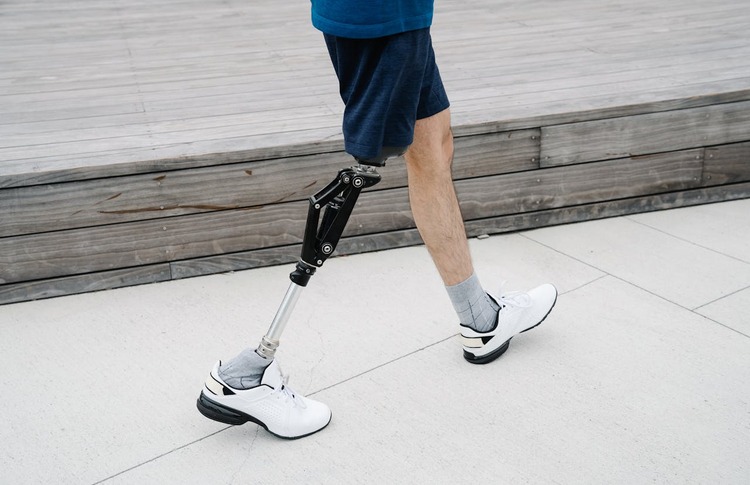In an era where the boundaries between humans and technology continue to blur, the concept of the augmented human is no longer confined to the realms of science fiction—it’s a tangible reality shaping our present and future. According to the statistics, as of 2020, approx. 590.1 million people globally were using wearable devices, marking a significant shift towards a tech-integrated society?
Picture this: a world where emotions can be read by machines, where tattoos aren’t just body art but gateways to a connected existence, and where cognitive enhancement challenges the very essence of human intelligence. From advanced neuroenhancement promising improved memory to emotionally intelligent robots becoming companions, the landscape of human augmentation is vast and evolving.
Join us on a journey into the uncharted territories where humans and machines converge:

Bionics and Prosthetics:
Traditional prosthetics have now evolved into highly sophisticated bionic limbs, equipped with sensors and AI, enabling users to control them with unprecedented precision. These marvels of engineering not only restore lost functionality but also push the boundaries of human capability. The integration of neural interfaces allows direct communication between the human brain and external devices, opening new avenues for amputees and individuals with paralysis to interact with the world in ways previously unimaginable.
Brain-Computer Interfaces (BCIs):
BCIs are paving the way for direct communication between the human brain and computers, enabling control of devices, applications, and even prosthetics with mere thoughts. The neuroscientific frontier is expanding as researchers delve into decoding the intricate language of the brain, offering the potential to enhance cognitive abilities, memory, and communication. As we unravel the mysteries of the mind, BCIs hold the promise of revolutionizing not just how we interact with technology but also how we understand and harness the power of our own thoughts.
Augmented Reality (AR) and Virtual Reality (VR):
AR and VR technologies are not just about immersive gaming experiences; they are making significant strides in enhancing real-world interactions. Augmented reality overlays digital information onto the physical world, providing enriched experiences in fields like education, navigation, and healthcare. Virtual reality, on the other hand, transports individuals to entirely different realms, offering unique opportunities for training, therapy, and exploration. These technologies are not merely entertainment; they are reshaping the way we perceive and engage with our surroundings.
Smart Implants and Wearables:
From smartwatches to implanted chips, wearable technology is becoming an integral part of our daily lives, monitoring health metrics, providing notifications, and facilitating seamless connectivity. The fusion of biology and technology, such as implantable devices like RFID chips, is unlocking new possibilities in security, identification, and even contactless payments. As our bodies become interconnected hubs of data, the implications for personalization, efficiency, and connectivity in the digital age are profound.
Genetic Engineering and CRISPR:
The CRISPR gene-editing tool is opening doors to precise manipulation of the human genome, potentially eliminating genetic disorders and enhancing desirable traits. This revolutionary technology brings with it a myriad of ethical considerations. The power to edit the blueprint of life raises questions about the definition of “normal” and the potential for creating designer babies. As we navigate the ethical tightrope of genetic engineering, the possibilities for reshaping the future of the human species are both awe-inspiring and morally challenging.

AI-Assisted Healthcare:
Artificial Intelligence is revolutionizing healthcare by analyzing vast amounts of data to identify patterns, predict diseases, and personalize treatment plans. AI-powered robotic surgery is becoming more commonplace, offering precision and efficiency beyond the capabilities of human surgeons alone. The collaboration between human intuition and machine intelligence is redefining the landscape of healthcare, promising not just better outcomes but also more accessible and efficient medical services.
Exoskeletons and Power Suits:
Exoskeletons are augmenting human strength and endurance, finding applications in industries like manufacturing and healthcare. These wearable robotic devices not only enhance physical capabilities but also redefine the limits of human potential. Power suits equipped with AI assistance are aiding soldiers and emergency responders, providing enhanced capabilities in critical situations. As we integrate machines seamlessly into our daily lives, the boundary between human and machine blurs, creating a new paradigm where the synergy between man and machine is greater than the sum of its parts.
Cybernetic Enhancements:
Cybernetic enhancements involve the integration of technology into the human body, with possibilities ranging from enhanced sensory perception to augmented cognitive abilities. As we embrace the idea of enhancing our natural capabilities with technological interventions, ethical concerns regarding the potential divide between those who can afford enhancements and those who cannot are emerging as society grapples with the implications of this technology. Striking a balance between accessibility and ethical use is crucial in ensuring that augmented humans contribute to a more equitable and inclusive future.

Social and Ethical Implications:
As we embrace augmented humanity, questions about privacy, consent, and the potential for misuse of technology come to the forefront. The societal impact of a technologically enhanced divide raises concerns about inequality and access to these advancements. Navigating the social and ethical dimensions of this transformative journey is as critical as the technological advancements themselves. How we address these concerns will shape the societal landscape for generations to come.
The Future of Augmented Humanity:
The pace of technological advancement shows no signs of slowing down, leaving us to wonder what the future holds for augmented humans. As we navigate this uncharted territory, it becomes crucial to strike a balance between technological innovation and ethical considerations, ensuring that the augmentation of humanity remains a force for good. The possibilities are vast, and the challenges are real, but as we stand at the cusp of a new era, the potential for positive transformation beckons us to explore the uncharted realms of human-machine symbiosis. The future of augmented humanity is not predetermined; it is a canvas waiting for the brushstrokes of human intent and ethical foresight.
Neuroenhancement and Cognitive Augmentation:
Advancements in neuroenhancement technologies represent a frontier in the quest to boost cognitive functions, offering the tantalizing potential for improved memory, heightened focus, and accelerated learning abilities. As we delve into this realm, ethical considerations come sharply into focus. The questions surrounding cognitive augmentation extend beyond the technical realm, raising issues of fairness, consent, and the potential societal impacts of creating an intellectually stratified population. Striking a balance between cognitive enhancement and ethical responsibility becomes paramount as we navigate the uncharted waters of augmenting the very core of human intelligence.

Human-Machine Collaboration in Workplaces:
The integration of AI and robotics into workplaces is not a narrative of replacement but collaboration. Augmented humans working in tandem with intelligent machines herald a paradigm shift, poised to redefine productivity and efficiency across various industries. This collaborative approach not only enhances the capabilities of human workers but also opens new frontiers of creativity and problem-solving. The workplace of the future is not a battleground between humans and machines, but a synergistic arena where the strengths of both are harnessed for unprecedented levels of innovation.
Emotional AI and Social Robots:
Emotional AI, a technological leap in imbuing machines with the ability to understand and respond to human emotions, is redefining our relationship with technology. As social robots equipped with emotional intelligence become more sophisticated, they seamlessly integrate into our lives as companions, caregivers, and educators. This integration blurs the lines between man and machine, challenging preconceived notions of emotional connections. The ethical considerations in this domain center on the potential impacts on human relationships and the responsibilities entailed in creating emotionally aware technology.
Technological Tattoos and Biohacking:
The emergence of technological tattoos and biohacking represents a deeply personal integration of electronics and sensors beneath the skin. This phenomenon enables individuals to interact with devices, store information, or monitor health in a seamless and unobtrusive manner. Beyond the cool factor, the ethical considerations pivot on issues of privacy, security, and the potential for misuse. As we venture into the era of biohacking, it becomes imperative to establish ethical guidelines that balance the benefits of seamless integration with the preservation of individual autonomy and privacy.
Conclusion
As we explore the realm of augmented humanity, a transformative era unfolds before us. From advanced bionics to emotional AI, each innovation reshapes our capabilities and challenges ethical norms. Widespread adoption of wearable tech and neuroenhancement statistics underscore the rapid evolution of our tech-human relationship. Yet, amid marvels, we must tread carefully, addressing fairness, consent, and societal impacts. The augmented human signifies more than biological-technological convergence; it’s a nuanced dance between progress and responsibility. Navigating this uncharted territory requires a collective commitment to wield advancements for societal betterment, ensuring a harmonious coexistence where man and machine synergy propels us towards an equitable and brighter future.
